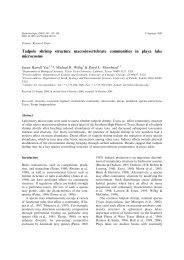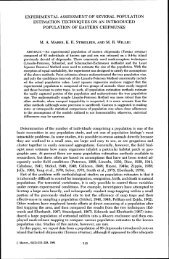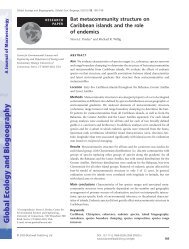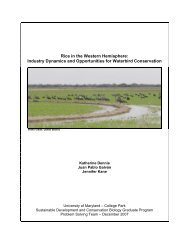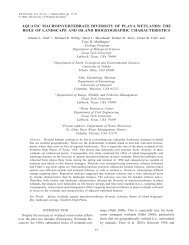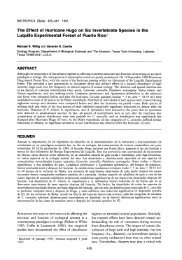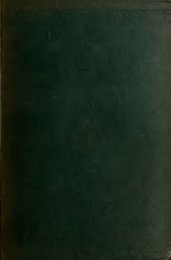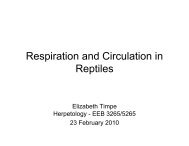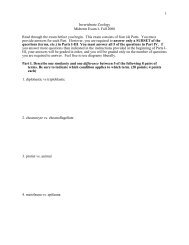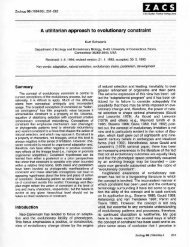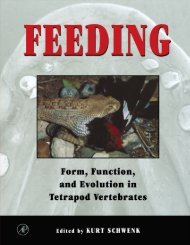Journal of Tropical Ecology (2006) - USDA Forest Service
Journal of Tropical Ecology (2006) - USDA Forest Service
Journal of Tropical Ecology (2006) - USDA Forest Service
You also want an ePaper? Increase the reach of your titles
YUMPU automatically turns print PDFs into web optimized ePapers that Google loves.
118 CHRISTOPHER P. BLOCH AND MICHAEL R. WILLIG<br />
sequential adjustment for four species (N. tridens, P.<br />
portoricensis, P. acutangula and S. octona).<br />
DISCUSSION<br />
Although previous studies have documented effects <strong>of</strong><br />
disturbance on terrestrial gastropod populations, this<br />
study represents the longest regularly sampled assemblage<br />
examined in this context. Time since disturbance<br />
for a variety <strong>of</strong> disturbance types (i.e. agriculture, fire<br />
or logging) had no effect on density <strong>of</strong> any species <strong>of</strong><br />
gastropod in New England forests, but the small size <strong>of</strong><br />
disturbed patches and their proximity to undisturbed<br />
forest probably accounted for a rapid return to predisturbance<br />
densities (Strayer et al. 1986). Elsewhere,<br />
abundance <strong>of</strong> snails typically decreases following fire<br />
(Karlin 1961) and logging (Hylander et al. 2004). Recovery<br />
<strong>of</strong> populations occurs over a period <strong>of</strong> years to<br />
decades. Young stands <strong>of</strong> conifers harbour low numbers<br />
<strong>of</strong> gastropods relative to old growth forests (Shikov 1984),<br />
but as regenerating forests enter later successional stages,<br />
densities <strong>of</strong> gastropods can exceed those in old growth<br />
(Ström 2004). Similarly, some gastropod species in the<br />
LEF exceeded pre-disturbance densities within 5 y after<br />
Hurricane Hugo (Secrest et al. 1996, Willig et al. 1998)<br />
despite large initial declines (Willig & Camilo 1991).<br />
The most directly comparable results to the present<br />
study are those <strong>of</strong> Willig and colleagues (Alvarez & Willig<br />
1993, Secrest et al. 1996, Willig & Camilo 1991, Willig<br />
et al. 1998), who used similar sampling techniques to<br />
examine the effects <strong>of</strong> natural disturbance on terrestrial<br />
gastropods in the LEF prior to Hurricane Georges. These<br />
studies clearly demonstrated that early responses <strong>of</strong><br />
gastropod populations can differ among disturbance types<br />
(i.e. hurricanes vs. individual treefalls). Current results<br />
extend this finding, suggesting that long-term responses<br />
also may differ among disturbance events <strong>of</strong> the same type<br />
(i.e. Hurricanes Hugo vs. Georges).<br />
Nenia tridens represents an example <strong>of</strong> contextdependent<br />
responses to disturbance. This species was low<br />
in density following both hurricanes, and increased in<br />
density over time following disturbance, suggesting that<br />
initial environmental conditions produced by hurricanes<br />
are inhospitable. In contrast, prior to Hurricane Hugo,<br />
density <strong>of</strong> N. tridens was greater in treefall gaps than<br />
in undisturbed forest, suggesting that N. tridens could<br />
exploit resources available in gaps (i.e. dead plant<br />
material and the algae and fungi that grow on it;<br />
Alvarez & Willig 1993, J. de Jesus, pers. comm.) without<br />
experiencing severe desiccation (Alvarez & Willig 1993).<br />
At that time, however, over 30 y had passed since the<br />
last major hurricane (Scatena & Larsen 1991, Turner<br />
et al. 1997). In tabonuco forest that had not recently<br />
experienced a major hurricane, treefall gaps may have<br />
been too small or topographically heterogeneous to develop<br />
extreme environmental differences from undisturbed<br />
forest (Alvarez & Willig 1993). The effect <strong>of</strong> a<br />
hurricane covers a greater area and produces many gaps<br />
comprising multiple treefalls, and may therefore produce<br />
more noticeable or different effects. Patterns <strong>of</strong> succession<br />
<strong>of</strong> trees, for example, differ between open patches created<br />
by hurricanes and gaps resulting from individual treefalls;<br />
pioneer species may be more important in treefall gaps<br />
than in patches generated by hurricanes (Vandermeer<br />
et al. 2000).<br />
Although Hurricane Hugo initially caused precipitous<br />
declines in population densities <strong>of</strong> terrestrial gastropods<br />
(Willig & Camilo 1991), a variety <strong>of</strong> species-specific<br />
population trajectories developed in subsequent years<br />
(Willig et al. 1998). No evidence in the present study<br />
contradicts these findings. Some species increased in<br />
density over time following disturbance, whereas others<br />
declined. Many species, in contrast, displayed no clear<br />
linear or quadratic response to disturbance. More<br />
interesting, perhaps, are differences in the effects <strong>of</strong><br />
the two hurricanes. Post-hurricane density or spatial<br />
variability <strong>of</strong> several species differed after Hurricane Hugo<br />
(from 1991 to 1998) compared with after Hurricane<br />
Georges (1999 to 2004). Moreover, patterns <strong>of</strong> change<br />
in population size or relative spatial variability <strong>of</strong> three<br />
species differed between the two hurricanes.<br />
The creation <strong>of</strong> canopy openings by hurricanes has<br />
two major effects: deposition <strong>of</strong> organic matter on the<br />
forest floor and modification <strong>of</strong> microclimate. An obvious<br />
trade-<strong>of</strong>f exists between these two effects; a hurricane<br />
that deposits more material on the forest floor will<br />
necessarily have a greater effect on microclimate, as<br />
a function <strong>of</strong> the larger size or wider distribution <strong>of</strong><br />
canopy openings. Both hurricanes, therefore, increased<br />
the resource base for terrestrial gastropods (e.g. litter and<br />
debris, either directly or as a substrate for algae, fungi,<br />
and other microbes; Heatwole & Heatwole 1978), while<br />
simultaneously producing unfavourable microclimatic<br />
conditions. Although Hurricane Georges deposited less<br />
debris than did Hurricane Hugo (Lugo & Frangi 2003,<br />
Ostertag et al. 2003), it also produced less extensive<br />
openings in the canopy (M.R. Willig et al., unpubl.<br />
data), which required less recovery time before canopy<br />
closure and the restoration <strong>of</strong> initial microclimatic<br />
conditions. Different responses <strong>of</strong> different species (or <strong>of</strong><br />
a single species among disturbance types or particular<br />
hurricanes) probably hinge on the relative sensitivities <strong>of</strong><br />
species to microclimate, habitat structure, and resource<br />
availability. Alcadia striata and C. squamosa may be<br />
prime examples. Both species appear to respond in<br />
lagged fashion. Immediately following a hurricane, when<br />
environmental conditions are most extreme, they exhibit<br />
low densities. Within 2 y, densities peak, perhaps because<br />
conditions have ameliorated sufficiently to allow these



